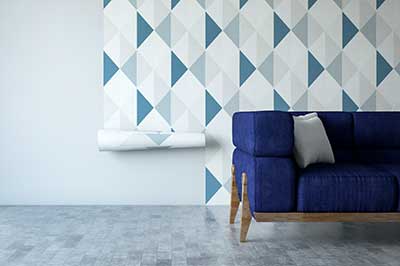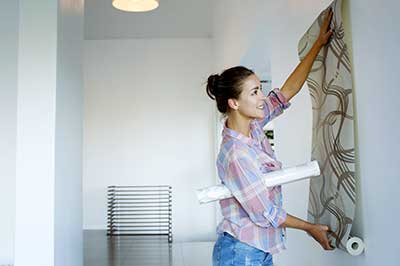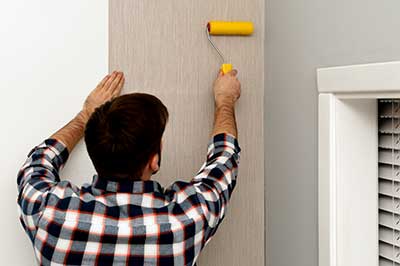Last updated March 24, 2021
On a Roll
Wallpaper is back. Here's what to do if you want it.
Twenty years ago, wallpaper was the kiss of design death, a murderously hard-to-remove blight from the 1980s (or earlier) that smacked of fussy grandmas and Victorian haunted houses. But like so many bygone home décor trends—macramé hangings, Mad Men-era furniture—wallpaper has rolled back in to style. The good news? It’s now easier to put up and take down, made with super-durable materials, and sometimes comes in peel-and-stick varieties you can slap up yourself.
“Many homeowners immediately think of the messy wallpaper installation and time-consuming removal process of our parents’ day,” said Brittany Ellis, owner of online wallpaper store The Pattern Collective. “This is not the case anymore! With proper wall preparation, such as using a primer specifically for wallpaper, steamers and messy chemical strippers are things of the past. With many of the wallpapers today, removal can be easier than installation.”
Much like adding a new coat of paint, decking your walls with a punchy floral or a groovy mural can completely transform a room. Do one accent wall, several bedrooms, or just tart up your dining space with a Chinese toile, Warhol-esque flowers, or indoor clouds.
 Chasing Down the Right Paper
Chasing Down the Right Paper
To get started—and get inspired—visit a local paint and wallpaper shop or big-box home improvement outlet and paw through sample books.
“But now you can also see hundreds of patterns on the internet versus flipping through endless books,” said Washington, D.C., wallpaper installer Michael DiGuiseppe. Sites with oodles of options (Tiger prints! Scottish tartans! A trellis formed of frogs!) include Anthropologie, DecoratorsBest, The Pattern Collective, Wallpaper Direct, and Wallpapers & Fabrics To Go. All have search engines that let you filter by price, color, and other categories.
Order samples of a few patterns before committing. Then, as you would with paint, tack options on the wall you’re thinking of bedazzling to see how they look at different times of day and whether they clash with existing furniture or fixtures.
Choosing a color, scale, or pattern is highly subjective, but DiGuiseppe advised that “papers with larger repeats are best for big spaces. Also be mindful of any irregularities in your space: crooked corners or uneven ceiling lines. A stripe or plaid would not be the best choice in that case, as it would highlight those flaws.” Also, know that wallpaper isn’t just for walls. “You can wallpaper the ceiling, line the back of bookshelves, or cover a piece of furniture,” said Ellis.
For bathrooms, kitchens, or other spaces subject to moisture or heavy use, look for scrubbable or contract-grade papers. This means they’re either vinyl made to look like paper (nicer looking than that sounds) or paper infused with polymers, vinyl, or other materials that can withstand shower steam, paw prints, and other daily challenges.
 Figuring How Much to Order Might Require Serious Math
Figuring How Much to Order Might Require Serious Math
For those of you who are bad with numbers, bad news: To figure out how much paper you need, you’ll have to do some careful math.
Different brands are sold in different increments, depending on where they come from. You’ll get different coverage from a standard-size U.S. double roll (usually 21 inches wide by 33 feet long) than you will for a European one. To further confuse things, some fancy-pants companies sell products by the yard, square foot, or meter. Add in pattern repeat and matching issues, and you might find yourself banging your head against a wall, not covering it in a nice fish print.
If you overestimate how much you need, you can usually return unopened rolls. If you underestimate, you can always order an extra roll and finish the project later. But both tasks are hassles.
DiGuiseppe sends his clients to wikihow.com/estimate-the-amount-of-wallpaper-needed for measuring help. And, of course, if you’re hiring a pro to do the work, ask them how much to buy.
The Cost of a Pretty Wall
The flat, hard truth: Putting up wallpaper will nearly always be more expensive than painting a room. Prices for a double U.S. roll can run anywhere from $25 to over $400 each, though $50-$150 a roll is about average. That double roll will cover approximately 60 square feet, meaning you’ll spend hundreds of dollars just for the five or six rolls needed to redo even a smallish room.
To save money, you can look for discontinued or vintage paper. But know that older wallpapers can be brittle and split as you work with them.
You can also opt to wallpaper just the top half of the walls, adding a chair rail (if you don’t already have one) to separate the bare wall below from the paper, a classic look in a dining room.
 The Basics of Decking Your Walls
The Basics of Decking Your Walls
While hanging wallpaper (or even ordering it) might seem easy to DIY, we highly recommend seeking a pro for all but the smallest, simplest jobs. While wallpaper won’t trash your place the way it used to, it’ll still vex your patience.
Whoever does the work will first have to remove any existing wallpaper. Spackle and sandpaper walls until smooth. Wipe off remaining dust, and remove outlet and switch covers. Then apply primer.
When you’re ready to paper, prep supplies: a tub of water (if you’re using self-adhesive paper) or a paint dish of wallpaper paste; a sponge or rag; a sharp work knife; a ruler and a surface you can cut on (a large cutting board or a piece of cardboard); and a stepladder to reach high spots.
Measure twice, cut once. Just before you get hanging, either submerge your cut, self-adhesive panel in water to activate the glue, or apply a thin-but-even coat of wallpaper paste to the unpasted paper.
Fold each end onto itself and set aside while you set up your ladder. Then unfold top half of folded paper, leaving lower half as is. Align the top edge to the ceiling.
You can make small adjustments as you put up the paper. With both self-adhesive paper and pasteable papers, it takes the sticky stuff 15 minutes or so to dry, giving you time to wiggle panels into place. Peel-and-stick varieties work like contact paper, meaning you can remove them and reposition them at least a couple of times.
Once the paper is up, smooth its surface outward with a damp sponge. Unfold the bottom half when ready. Any bubbles you can’t smooth will dissipate as the paper dries. Go easy with the smoothing so you don’t push out the glue from underneath, or your paper won’t stick to the wall.
Then line up your next sheet, carefully matching patterns. Hang from left to right, then trim any excess paper at the bottom after everything is dry—about three hours.
Carefully use your box cutter to trim edges or cut out holes for outlets.
 Hiring a Pro Hanger
Hiring a Pro Hanger
Wallpaper is expensive, and while these days it’s easier to remove and hang than in decades past, you’ll probably live with it for years. So, again: We recommend hiring a professional installer. They’ll save you from ruining expensive paper with clumsy hanging and make quick work of a highly technical, specialized job. Expect to pay from $3 to $8 per square foot for installation, depending on the complexity of the job and whom you hire.
As with any service pro, get price quotes from at least three companies. Ask each how much paper you’ll need and for a fixed price to hang it. Ask to see photos of their work and for names of recent clients for references; then contact them.
Many painting operations hang wallpaper, but make sure they have workers with several years’ experience. “Since wallpaper has made such a strong comeback, many contractors and other tradespeople have started adding ‘wallpaper hanger’ to their repertoires without the proper training, which can lead to disaster,” said Ellis.
You can also get recommendations from staff at local wallpaper stores or interior design centers.

